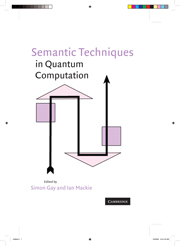Book contents
- Frontmatter
- Contents
- Contributors
- Preface
- 1 No-Cloning in Categorical Quantum Mechanics
- 2 Classical and Quantum Structuralism
- 3 Generalized Proof-Nets for Compact Categories with Biproducts
- 4 Quantum Lambda Calculus
- 5 The Quantum IO Monad
- 6 Abstract Interpretation Techniques for Quantum Computation
- 7 Extended Measurement Calculus
- 8 Predicate Transformer Semantics of Quantum Programs
- 9 The Structure of Partial Isometries
- 10 Temporal Logics for Reasoning about Quantum Systems
- 11 Specification and Verification of Quantum Protocols
- Index
- References
1 - No-Cloning in Categorical Quantum Mechanics
Published online by Cambridge University Press: 05 July 2014
- Frontmatter
- Contents
- Contributors
- Preface
- 1 No-Cloning in Categorical Quantum Mechanics
- 2 Classical and Quantum Structuralism
- 3 Generalized Proof-Nets for Compact Categories with Biproducts
- 4 Quantum Lambda Calculus
- 5 The Quantum IO Monad
- 6 Abstract Interpretation Techniques for Quantum Computation
- 7 Extended Measurement Calculus
- 8 Predicate Transformer Semantics of Quantum Programs
- 9 The Structure of Partial Isometries
- 10 Temporal Logics for Reasoning about Quantum Systems
- 11 Specification and Verification of Quantum Protocols
- Index
- References
Summary
Abstract
The no-cloning theorem is a basic limitative result for quantum mechanics, with particular significance for quantum information. It says that there is no unitary operation that makes perfect copies of an unknown (pure) quantum state. We re-examine this foundational result from the perspective of the categorical formulation of quantum mechanics recently introduced by the author and Bob Coecke. We formulate and prove a novel version of the result, as an incompatibility between having a “natural” copying operation and the structural features required for modeling quantum entanglement coexisting in the same category. This formulation is strikingly similar to a well-known limitative result in categorical logic, Joyal's lemma, which shows that a “Boolean cartesian closed category” trivializes and hence provides a major roadblock to the computational interpretation of classical logic. This shows a heretofore unsuspected connection between limitative results in proof theory and no-go theorems in quantum mechanics. The argument is of a robust, topological character and uses the graphical calculus for monoidal categories to advantage.
1.1 Introduction
The no-cloning theorem (Dieks 1982; Wootters and Zurek 1982) is a basic limitative result for quantum mechanics, with particular significance for quantum information. It says that there is no unitary operation that makes perfect copies of an unknown (pure) quantum state. A stronger form of this result is the no-broadcasting theorem (Barnum et al. 1996), which applies to mixed states. There is also a no-deleting theorem (Pati and Braunstein 2000).
- Type
- Chapter
- Information
- Semantic Techniques in Quantum Computation , pp. 1 - 28Publisher: Cambridge University PressPrint publication year: 2009
References
- 23
- Cited by



